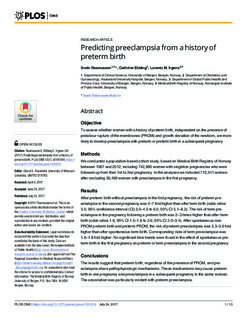| dc.description.abstract | Objective To assess whether women with a history of preterm birth, independent on the presence of prelabour rupture of the membranes (PROM) and growth deviation of the newborn, are more likely to develop preeclampsia with preterm or preterm birth in a subsequent pregnancy. Methods We conducted a population-based cohort study, based on Medical Birth Registry of Norway between 1967 and 2012, including 742,980 women with singleton pregnancies who were followed up from their 1st to 2nd pregnancy. In the analyses we included 712,511 women after excluding 30,469 women with preeclampsia in the first pregnancy. Results After preterm birth without preeclampsia in the first pregnancy, the risk of preterm preeclampsia in the second pregnancy was 4-7 fold higher than after term birth (odds ratios 3.5; 95% confidence interval (CI) 3.0-4.0 to 6.5; 95% CI 5.1-8.2). The risk of term preeclampsia in the pregnancy following a preterm birth was 2-3 times higher than after term birth (odds ratios 1.6; 95% CI 1.5-1.8 to 2.6; 95% CI 2.0-3.4). After spontaneous non-PROM preterm birth and preterm PROM, the risk of preterm preeclampsia was 3.3-3.6 fold higher than after spontaneous term birth. Corresponding risks of term preeclampsia was 1.6-1.8 fold higher. No significant time trends were found in the effect of spontaneous preterm birth in the first pregnancy on preterm or term preeclampsia in the second pregnancy. Conclusions The results suggest that preterm birth, regardless of the presence of PROM, and preeclampsia share pathophysiologic mechanisms. These mechanisms may cause preterm birth in one pregnancy and preeclampsia in a subsequent pregnancy in the same woman. The association was particularly evident with preterm preeclampsia. | |
